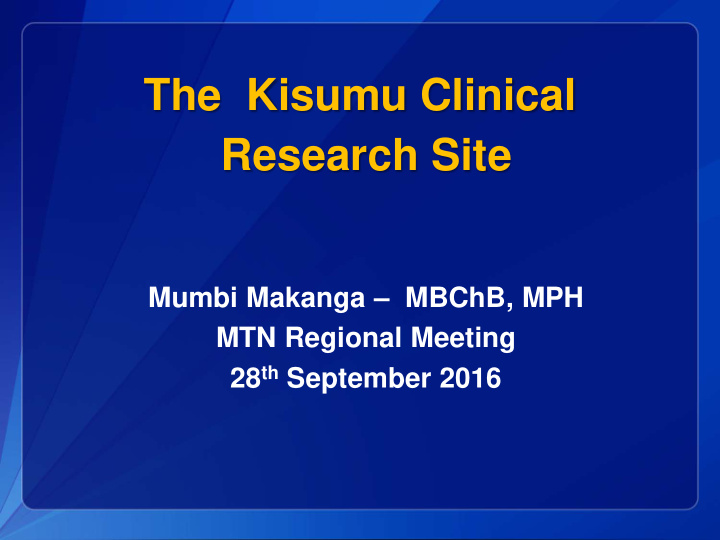



The Kisumu Clinical Research Site Mumbi Makanga – MBChB, MPH MTN Regional Meeting 28 th September 2016
Overview –History of the Kisumu CRS –Communities Served by the Kisumu CRS –Completed Studies / Clinical Trials –Current Studies / Clinical Trials –Nuvaring Experiences –MTN 034 in Kisumu CRS
KISUMU CRS
History of the Kisumu CRS Main location is KEMRI Clinical Research Centre (CRC) Campus of largest western Kenya referral hospital (JOOTRH) Kenya Medical Research Institute (KEMRI) / Centers for Disease Control and Prevention (CDC) partnership Became DAIDS Network CRS in December 2013 Emory CTU ACTG network since 2013 and HPTN beginning in 2016
Communities Served Past studies included General Population Adolescents girls and boys Discordant Couples Female Sex workers Men who have Sex with Men Fisher Folk Pregnant and breast feeding women Women of reproductive potential
Research Capabilities KEMRI and CDC partner research programs HIV TB Malaria Emerging infections NCDs Laboratory ISO accredited HIV and TB laboratory Regional WHO accredited HIV drug resistance reference Laboratory
Current / Completed studies ACTG studies A5279, A5288, A5316, A5297 , A5263, A5300, A5338, A5290, A5344, A5349 (TBTC Study 31), A5243 HPTN studies HPTN 052 HPTN 075: observational cohort study to determine feasibility of recruiting MSM in preparation for HIV prevention studies in Africa HPTN 081 (AMP Study): VRC01 broadly neutralizing monoclonal antibody prevention of HIV-1 HPTN 052 rewarded for best recrutment award in 2010 and best retetion awards for 2010 and 2011.HPTN 075 recognised fo r most innovative site in terms of community recruitment of MSM in 2016
Other HIV Specific Studies Kisumu Breastfeeding Study (KiBS) – 2004-2009 Demonstrated effective prevention of mother-to-child transmission and informed both WHO and Kenya national guidelines in 2009 KICOS Adolescent Study – 2010 Successfully involved adolescents in HIV prevention research Nuvaring Study – 2014-2015 Examines adherence, acceptability and biological effects of intra-vaginal combined hormonal contraceptive ring among HIV (–) women 53 participants were ≤ 21 years of age
Kisumu CRS Studies Involving Adolescents Study Age Range of No. of participants Product Number/Name Participants enrolled 3864 participants (966 Moon Cup Moon Cup 13-19 per arm) in 84 clusters Study menstrual cup (21 schools per arm) PIRE 15-19 Observational 1500 108 participants to be enrolled; 48 participating in Game Study 11-14 Video Game formative research and 60 in intervention) and their parents or caregivers.
Nuvaring Experiences Aim: To assess the adherence, acceptability and biologic effects of a hormonal contraceptive IVR among sexually active young women 692 pre-screened 302 participants enrolled 210 started on ring over 3 months Retention over the 6 months was 87%
Lessons Learned Comfort during invasive procedures like pelvic exams by using privacy and female clinicians Avoid too many invasive procedures Alleviate the fears of participants through counseling and demonstration of procedures Women whose partners knew about their involvement in the study generally had better adherence
Kisumu CRS and MTN 034 High burden of HIV and unintended pregnancies among adolescents and young women in our region The site has conducted studies that have successfully involved adolescents (an underserved and critical population) in HIV prevention research
Planned Recruitment Strategies School based approaches Youth friendly centers and organizations Community Advisory Boards (CABs) & Youth Advisory Boards (YABs) Snowballing / peer-to-peer Community Healthcare Workers (CHEWs/ CHWs) Youth friendly activities and hotspots e.g. youth based religious activities events and entertainments spots like discos and hang-out joints
Planned Retention Strategies Youth Friendly clinic that include flexible scheduling, re- scheduling, warm reception and short waiting time Adolescent entertainment such as TV and videos, indoor games and reading places and materials Transport assistance Reimbursement for study activities and appreciation packages Enhanced follow-up Regular polite reminders for clinic appointments Detailed locators and contact information followed by home verifications upon enrollment
Acknowledgements EMORY-CDC Clinical Trial Unit(CTU) KEMRI CGHR CDC ATLANTA
Recommend
More recommend